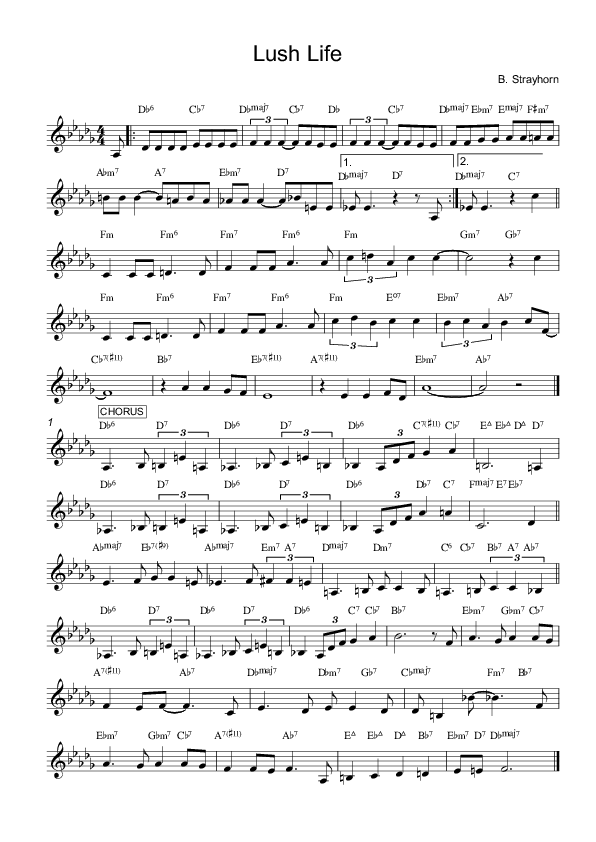Analysis
Lush Life
Lush Life is a song that Strayhorn wrote very early in his career, around 1936, when he was still living in his hometown Pittsburgh and working on his first musical theatre productions. Originally entitled Lonely Again, it would later become one of his most famous and most frequently played compositions, yet it dates back to his pre-Ellington period. It is easy to see that Lush Life is a classic show tune: music and text came out of the same feather and are closely interlaced. This one of the few present-day jazz standards of which not only the chorus, but also the verse of the original show tune is usually being played.
From the narrator’s perspective, Strayhorn tells us a tale of a careless life full of pleasure and sin. The first 7 bars (repeated) of the verse underline this picture with a long ascending melody line in Db melodic major – ironically sound-painting the word “jazz” with a tritone-jump down to the non-diatonic not Fb. The mood changes in the second half of the verse: the new tonic is an F minor pedal, the plot turns to rejected love and resignation. The last 6 bars of the verse modulate back to Db and lead to the moral conclusion, presented in the chorus: “Life is lonely again”.
The verse seems like an opera recitative, with a freely flowing text and thoroughly through-composed accompaniment.
In the chorus, again, the harmonies roughly move in and around Db major, starting out with the characteristic twist of this composition: the half-measure rocking movement between Db6 and D7#11, D7 being the upper-chromatic dominant. On beat 3 and 4, the D7 chord, the tonal material of the melody also shifts chromatically to D mixolydian, which gives an obscurity to it, emphasized rhythmically by quarter-note triplets. This happens for 3 three bars, beat 3 and 4 of bar 3 leading to E major. In bar 4, the chords Emaj7-Ebmaj7-Dmaj7-D7 descend in quarter notes and end up on Db6 in bar 5. After a repetition of the first 3 bars, the harmony moves, passing F major, to the subdominant Ab, to D and back to Db.
The ending of chorus is idiosyncratic as well and it stays in mind: an ascending chromatic line of quarter notes in the melody, underscored by descending quarter-note chords.
Lush Life is a complex song; its melody is difficult to remember or sing along due to tritone-substituted chords, chromaticism and big jumps. One vehicle for this harmonic complexity is the so-called axis system. Hungarian musicologist Ernö Lendvai has described this occurrence in Béla Bartók’s music in 19711; it can as well be found in jazz pianist Barry Harris’s method based on the diminished2. The basic concept says that four different major scales, a minor third apart from each other, have one diminished seventh chord in common, on the seventh degree of each scale. If you treat this diminished chord as the upper structure of a dominant, it leads to one out of four possible tonics. This way, the tonal center can be moved along an axis of minor thirds. The use of the diminished as a pivot enables modulations. For example, in bar 3 of the chorus of Lush Life, B7 is a dominant for the following Emaj7. Coming from the key of Db, the diatonic dominant Ab7 and the secondary dominant B7 both contain the diminished chord C-Eb-Gb-A (enharmonically used), with a flat 9 as extension.
In the verse, we can see the same phenomenon: In the first 3 bars, there is a rocking movement between the preliminary tonic chord Dbmaj7 and Cb7. The latter is the actual dominant for Emaj7. On beat 3 of bar 4, a modulation to this anticipated key of E takes place. Again, Dbmaj and Emaj share the dimished chord. Beyond that, Emaj can be put in the context of Db minor.
Strayhorn made use of this method in several of his works.
1See, for example: Van de Leur, p. 28-29
2See, for example: Vera Marijt, 2014. Barry Harris: Exploring the Diminished. KC Research Portal www.researchcatalogue.net (23.10.2014)
